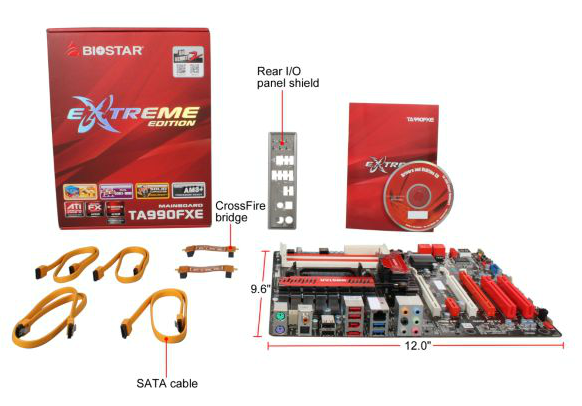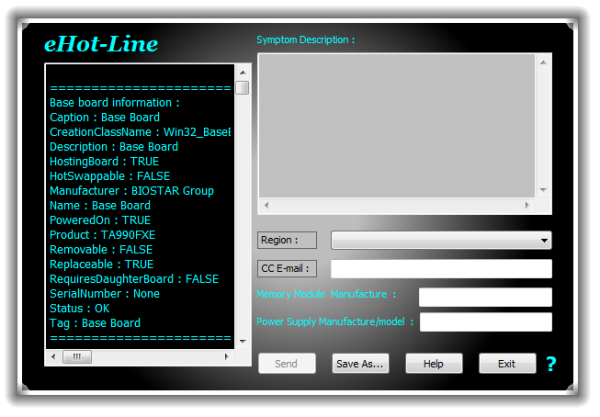990FX Motherboard Roundup with Thuban and Bulldozer – A Second Wind for ASUS, Gigabyte, MSI and Biostar
by Ian Cutress on April 5, 2012 11:00 AM ESTBiostar TA990FXE In The Box
In The Box
For a cheap board, we would expect a bare box with limited additions, reminiscent of what certain other manufactures may put in there. But I was quite surprised:
IO Shield
Driver CD
User Manual
Six SATA cables (locking)
Two Crossfire bridges
The addition of Crossfire bridges is odd, as typically SLI bridges are given in boards (although the initial BIOSes of this board did not support SLI). Also worthy of note is that the CPU back bracket on the board did not function with AMD all-in-one cooler.

Image courtesy of Newegg
Board Features
| Biostar TA990FXE | |
| Price | Link to Newegg |
| Size | ATX |
| CPU Interface | AM3+ |
| CPU Support | AMD FX/Phenom II/Athlon II/Sempron |
| Chipset | AMD 990FX |
| Base Clock Frequency | Auto, 200 MHz to 600 MHz |
| Core Voltage | Auto, 0.70 V to 1.55 V, Offset +0.50 V to +1.450 V |
| CPU Clock Multiplier | Auto, x8 to x31.5 |
| DRAM Voltage | Auto, -0.25 V to +0.49 V |
| DRAM Command Rate | Auto, 1T or 2T |
| Memory Slots |
Four DDR3 DIMM slots supporting up to 32 GB Up to Dual Channel Support for DDR3, 800-2000 MHz, |
| Expansion Slots |
2 x PCIe Gen2 x16 (x16/x16) 1 x PCIe Gen2 x4 2 x PCI |
| Onboard SATA/RAID | 5 x SATA 6 Gbps, Support for RAID 0, 1, 5, 10 |
| Onboard |
5 x SATA 6 Gbps (SB950) 3 x Fan Headers 1 x Front Panel Header 1 x S/PDIF Output Header 2 x USB 2.0 Headers 1 x USB 3.0 Headers 1 x IEEE1394 Header 1 x Serial Port Header 1 x CIR Header |
| Onboard LAN | Atheros AR8151 |
| Onboard Audio | Realtek ALC892 |
| Power Connectors |
1 x 24-pin ATX connector 1 x 8-pin 12V connector 1 x 4-pin Molex connector |
| Fan Headers |
1 x CPU Fan Header 2 x SYS Fan Headers |
| IO Panel |
2 x Keyboard/Mouse PS2 Port 1 x Optical SPDIF Output 1 x Coaxial SPDIF Output 1 x Gigabit Ethernet 2 x USB 3.0 4 x USB 2.0 1 x eSATA 3 Gbps Port 1 x IEEE1394 Port Audio Outputs |
| BIOS Version | 29/02/2012 |
| Warranty Period | 3 Years from Manufacture date |
As I mentioned in the TA990FXE overview, there are a few oddities. The placement of the PCIe slots is questionable as it doesn't allow a gap between multi-GPU systems, and the inclusion of the Atheros network controller rather than a Realtek (for the combo discount) is odd. The lack of fan headers is a concern.
Software
As we have never covered Biostar software before, it was worth my time to dig deep into what makes Biostar tick in this regard. The myriad of software comes down a few key utilities - eHotLine, BIOS Update, TOverclocker and G.P.U.
eHotLine: This software seems to be part of Biostar's bug reporting. Have an issue with your board, and this software pulls almost all the necessary info for you to send to them to help diagnose it.

BIOS Update: Does exactly what it says on the tin - even better if you are connected to the internet, as then it will search for the latest BIOS it can find from the Biostar servers, then download it and install.
TOverclocker: The main hub of software action takes place in TOverclocker. On loading, it will apply any overclock previously set (even if it crashes your system), but offers information on the CPU, Motherboard and memory. The OC Tweaker allows the user to change the base frequency and select the overclocking mode - the voltage options did not work on the Bulldozer processor. H/W Monitor shows the voltages and temperatures, and even offers a CPU fan calibration tool.

G.P.U: The confusing part of the software is this - the Green Power Utility. Why it was called GPU I have no idea, but this software takes a while to load and attempts to adapt the system to use less voltage.


















57 Comments
View All Comments
IanCutress - Thursday, April 5, 2012 - link
Unfortunately we don't have an infinite amount of kit to review with. We're individual reviewers here, not all working in a big office. Obviously we can't all request top end kit from manufacturers either. Plus for every time we do use new high end kit, we also get comments about testing something 'more realistic' to most users. In that circumstance, we can't win and please everyone, but we do try and be as consistent as possible.Ian
phocean - Thursday, April 5, 2012 - link
I bought the Sabertooth a few weeks ago... and it throws an annoying buzzing sound in the speakers, especially when a USB port is used (in other words, all the time).It is the sign of an isolation issue between chipsets and shows poor design and testing from Asus.
Needless to say that the support was of no help (and no willing to help).
So don't buy it, unless you don't plug any speaker in it.
richaron - Friday, April 6, 2012 - link
Mine doesn't have this problem. You either got an unlucky board, or your psu is funky.extide - Thursday, April 5, 2012 - link
Seem to me like you were probably using a bit too much voltage for the BD. I would assume that is why you had so many issues with thermal runaway. 1.4-1.45ish would probably be a better place to stay with an air cooler :)extide - Thursday, April 5, 2012 - link
EDIT: Nevermind I forgot you are using the AMD kit watercooler, which is better than straight air cooling but I'd think it would take more of a fully custom built water setup to run 1.5v vCore.Hrel - Thursday, April 5, 2012 - link
I was going to build a new computer based on Ivy Bridge this Fall, I'm still running a Core 2 Duo E8400. But I've decided I'm not building myself a new computer until the motherboard has USB 3.0 and ONLY USB 3.0. A LOT of them, EVERYWHERE!I just built a guy a Z68 based computer with an i7 2700K but I had to order a VERY hard to find adapter card to plug in the USB 3.0 based memory card reader and the USB 3.0 on the front of the Fractal Design case. Because the Asus motherboard has ZERO USB 3.0 headers on it. It never even occurred to me that was a possibility. Not only has USB 3.0 been out for years now, but it was released WAY over-due. WTF is the hold up. Make the switch. USB 2.0 is for the 2000's decade, it's 2012. I am done with USB 2.0. I shouldn't have to buy an add-in card for BRAND NEW motherboard to support basic accesories, like a memory card reader and front usb port.
This is related to this article because I think if AMD was actually competitive with Intel AT ALL, like they were with Athlon XP/64/64 X2, then Intel would step up their game all around. Or maybe I wouldn't even have to buy Intel because they constantly make shit decisions like this, and changing the motherboard socket constantly, and charging 300 dollars for a quad core with HT. Their shit is endless and I really don't want to buy their products but AMD is simply not an option; if I wanted something that slow I'd just put a quad core Penryn based CPU in my current rig and save a bunch of money.
ggathagan - Friday, April 6, 2012 - link
There are only two Asus Z68 boards that don't have the USB 3 header, but somehow it's *Intel's* fault that Asus didn't use a USB 3 header on the board you bought?Huh...
Maybe you should have been a little more attentive when board shopping.
IanCutress - Friday, April 6, 2012 - link
Hi Hrel,I actually like USB 2.0 on my boards. If you have solely USB 3.0 and use them all, there's a big chance of a bottleneck in the bus somewhere. Also, I install a fresh operating system on every board I test via USB as it is a lot quicker than CD. Unfortunately during the install program, it doesn't process anything through the USB 3.0 ports - mouse, keyboard, or even the USB stick with the OS on. So I ideally like to have three USB 2.0 ports for that purpose. It's more a fault of Windows7 than the chipset, but otherwise if a board only has two USB 2.0 ports, I have to disconnect the mouse and use the keyboard and USB install drive only. Saying that, I have a board in that is solely USB 3.0, so it's going to be fun to install an OS on that... :/
Ian
fic2 - Friday, April 6, 2012 - link
I have a Dell keyboard that has 2 USB ports on it. That would solve your problem with a 2 x USB 2 mb. I currently have the mouse daisy chained off the keyboard.B - Thursday, April 5, 2012 - link
Your article should note that sound blaster provides a software overlay, but under that aluminum skin overlay lies a Realtek chip. I was fooled by this marketing and very disappointed after configuring this motherboard and discovering this fact. You don't get soudblasters hardware acceleration or the crystalizer. You should note this in any article about the asus line with x-fi2. Had I known I would have done things differently.